Ingmar Bergman the stage director
One of Sweden’s – and the world’s – most productive theatre directors.
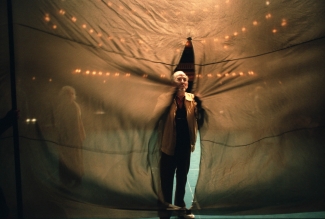
As a man of the theatre, Ingmar Bergman is probably best known for his productions of the classics of the stage. Shakespeare, Molière, Ibsen and Strindberg all had an enormous influence, not only for his work in the theatre, but also for his artistic output in general. Bergman's exceptional ability to interpret and discover new aspects in historical dramas and to give them life and relevance for our own age made him one of the great theatre directors. For Bergman, the work and its essence, what he regarded as the dramatist's intention behind the play, constituted one of the three pillars of the theatre, alongside the actors and the audience.
He had a deep-rooted scepticism towards all kinds of showmanship and gimmickry in the theatre. In Bergman's view the theatre should be 'man's interface with man' and nothing else besides, distancing himself from such directors as Peter Brook, Giorgio Strehler and Frank Castorf. Instead, the theatrical figures to whom he expressed a debt of gratitude were major Swedish figures such as Torsten Hammarén, Alf Sjöberg and Olof Molander, Hammarén because he taught him how to 'work coldly, clearly and methodically', and Sjöberg and Molander for their Shakespeare and Strindberg productions respectively.
Even though Bergman himself, like Max Reinhardt before him, rejected the idea that there can be a special style to be applied to all plays, there are, on closer inspection, recurring elements and devices that can collectively be described as a Bergmanesque theatrical directing style. In his early years there was a clear production concept characterised by basic scenery, interpretative choices, a sensitivity to the play's rhythm and to the audience's response, and a coordinated use of stage design and actors to form a visual whole. In his eager desire to uncover the essence of any play, Bergman did not shy away from making cuts, often fairly drastic in nature. And in Bergman's productions, the actors literally occupied a central role. He placed the action in what he called the focal point, the area of the stage where he felt that the actors would have the greatest effect on the audience. Another device was to use the actors to amplify the theatricality of the play: they were often present on stage even in scenes in which they do not participate, as silent observers. Thus Bergman allowed the audience to take part in the magical ritual which never ceased to fascinate him, the one in which the actors bring their roles to life.
It all started with puppet theatre, with which he began to experiment at the age of 11, and which he developed to a highly sophisticated extent prior to his entry into 'real' theatre in the late 1930s. Right from the outset Bergman was inspired by his house gods, Alf Sjöberg, whose Big Klas and Little Klas was his first experience of the theatre at The Royal Dramatic Theatre in 1930 and Olof Molander, whose production of A Dream Play (1935) Bergman described as 'the bedrock of all theatre experiences'.
Lars Hansson, who worked at Mäster Olofsgården in Stockholm, was absolutely clear as to why that theatre took a major step forward in 1938. 'MO had the great good fortune to come into contact with the 19-year-old Ingmar Bergman'. At university in Stockholm, Bergman had attended Martin Lamm's lectures on Strindberg, but apart from his puppet theatre, he had no experience of his own.
Bergman soon abandoned both Lamm and his parental home for the life of the theatre at Mäster Olofsgården. His first production was Sutton Vane's Outward Bound. Rumours about Bergman's rigorous rehearsal regime, his loose language and violent tempers quickly spread, giving rise to the nickname that stuck with him throughout his career, the 'demon director'.
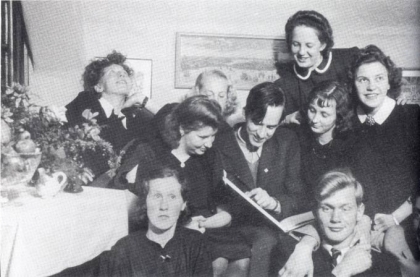
Bergman with the cast of Outward Bound.
© Mäster Olofsgården
The period spent at Mäster Olofsgården was a successful one. Bergman directed Shakespeare and Strindberg for the first time, and his productions soon drew the attention of the media. 'There are amateur theatres and amateur theatres – Mäster Olofsgården is among the latter category', wrote Dagens Nyheter's Oscar Rydqvist about Macbeth, a production in which Bergman also took part as an actor.
Bergman's reputation grew, and when one of Sweden's foremost children's theatres, Sagoteatern, opened up in 1941 and staged plays at Stockholm's Civic Centre, Bergman was chosen as its head. The first play he directed was The Tinder Box, and just two weeks later, Stockholm's smallest theatre company at the time, Medborgarteatern, opened up at the same address as Sagoteatern. Its first production was The Ghost Sonata, Bergman's first collaboration with Gunnar Björnstrand. Despite favourable reviews, the production was a box-office flop that closed after just one week, whereupon Bergman returned to children's theatre. In total, Bergman staged seven productions at the Civic Centre.
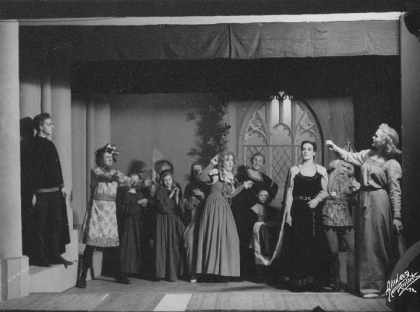
The Tinder Box at Sagoteatern.
Photo: Almberg & Preinitz Fotografiateljé © Almberg & Preinitz Fotografiateljé
In 1940 Bergman had established contact with the Stockholm Student Theatre, a definite advancement in his career. He gained access both to professional actors and students from The Royal Dramatic Theatre stage school. Here he first encountered a number of people he was to work with for many years ahead, including Erland Josephson, Birger Malmsten and Ulf Johanson. In 1942, he directed for the first time a play which he himself had written, Death of Punch. Over the next ten years he wrote at least nine other plays, six of which he staged and directed. Bergman's skills as a writer gained him his first job in films as a screenwriter and assistant director at Svensk Filmindustri.
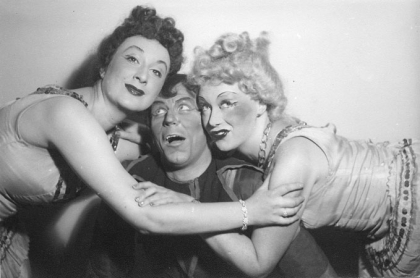
Death of Punch at Stockholm Student Theatre.
Photo: Almberg & Preinitz Fotografiateljé © Almberg & Preinitz Fotografiateljé
In 1943 Bergman joined The Dramatist Studio, where the writer Brita von Horn was the driving force. Here he directed plays by Swedish dramatists, some of whom were newcomers. At another Stockholm theatre, Boulevardteatern, Bergman directed The Hotel Room, to much acclaim.
In 1944 Bergman took over as head of the Helsingborg City Theatre, thus becoming, at the age of 26, the youngest head of a major theatre in Europe. Having recently lost its state funding, the theatre itself was on the brink of ruin. His task was to bring back the audiences, and consequently, the repertoire became 'shamelessly populist', according to Bergman himself. It ranged from the ever-present Strindberg and Shakespeare to premieres of a number of Swedish plays, such as Olle Hedberg's Rabies and Björn-Erik Höijer's Requiem. Productions came thick and fast, and rehearsal times were short. The actors however, several of whom had followed Bergman from Stockholm, were used to the director's strict codes of discipline at work, and audience numbers grew. One year later, the theatre had its state funding restored.
Following his time in Helsingborg, Bergman staged his own Rachel and the Cinema Doorman as a guest director on the small stage at the Malmö City Theatre. In 1946 Bergman was invited to direct at the Gothenburg City Theatre, Sweden's most political theatre at the time, working under Torsten Hammarén. Bergman and Hammarén often found themselves at loggerheads, and Hammarén regarded Bergman as 'a provincial genius'. Bergman later expressed his deep gratitude to his boss at the time. 'Torsten taught me the basic methodology of staging. He led me firmly away from any illusions of wallowing in emotion.'
After just a couple of years at Gothenburg City Theatre, the critic Ebbe Linde wrote of Bergman, 'When it comes to directing his cast, magnificence, ideas and understanding of the text, it is hard to name anyone in this country who is indisputably superior to this former eccentric.'
Among the playwrights staged was Albert Camus, whose Caligula Bergman directed to great acclaim. The plays he had written himself, The Day Ends Early and Unto My Fear, however, received only a lukewarm reception. During his time in Gothenburg, Bergman made several lengthy excursions to Paris, where he visited the Comedie Française and discovered Molière.
Also at this time, Bergman's work in film began to be reflected in his work in the theatre, and vice versa. He began, for example, to project shadows in silhouette, a device he used in many of his films.
In 1950 Bergman returned temporarily to Stockholm to direct at Lorens Marmstedt's newly-opened Intima Teatern, where he staged his only Brecht play, The Three-Penny Opera. Following a short period at The Royal Dramatic Theatre with a new play Light in the Shack and a guest appointment at the Norrköping City Theatre, Bergman went back to Skåne in 1952, where he was appointed director and artistic advisor at the Malmö City Theatre.
Bergman described this period as the best in his career, aided by the fact that he was given a completely free rein. It marked the beginning of his heyday as a theatre director: among his Malmö productions, Peer Gynt, The Misanthrope, and Dom Juan have taken their place in Swedish theatre history.
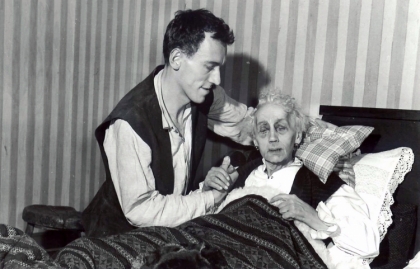
Max von Sydow and Naima Wifstrand in Peer Gynt.
Photo: Georg Oddner © Malmö Opera Archives
It was here too that a slightly revised Bergman ensemble began to take shape, including Harriet Andersson, Gunnel Lindblom, Naima Wifstrand, Bibi Andersson, Ingrid Thulin and Max von Sydow, who, in his first Bergman role, played the lead in the critically acclaimed Peer Gynt. During the period, Bergman also developed his celebrated interweaving of theatre and film, in which his ensemble acted in plays during the season and made films during the summer. He also developed a more humble style of directing, with himself as 'the sounding board against which the actors can react'. His repertoire ranged from popular comedies and operettas through to Strindberg. Internationally his reputation also grew, not least when Ur-Faust and Peer Gynt were staged abroad as guest productions.
Having left Malmö, Bergman concentrated solely on film for a period of two years. In 1961 he returned to the stage with a production of The Seagull at The Royal Dramatic Theatre. Expectations were high for his first venture into Chekhov, but following a tepid response, he temporarily abandoned The Royal Dramatic Theatre for a new medium, opera, staging The Rake's Progress at the Royal Swedish Opera. Although it was a great success, it was not until The Bacchae in 1991 that Bergman returned to opera on the stage. In between time, he did direct The Magic Flute for television in 1975.
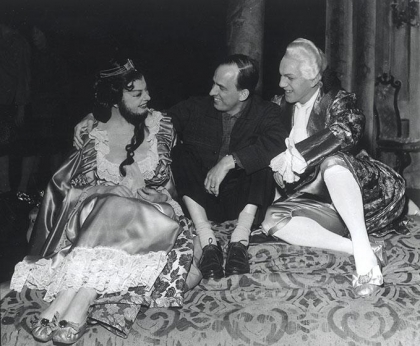
Bergman with Kerstin Meyer and Ragnar Ulfung during rehearsal of The Rake's Progress.
Photo:Enar Merkel Rydberg © Musik- och teaterbiblioteket, Statens musikverk
In 1963 Bergman accepted the post as head of The Royal Dramatic Theatre. His first play in charge was the European premiere of Edward Albee's Who's Afraid of Virginia Woolf? Further contemporary plays were to follow, including the world premiere of Harry Martinsson's Three Knives from Wei. In 1967 Bergman was a guest in Oslo, where he directed Six Characters in Search of an Author at the National Theatre. In 1970 he was a guest in London, where Laurence Olivier had persuaded Bergman to stage Hedda Gabler at the National Theatre with Maggie Smith in the title role. On his return to The Royal Dramatic Theatre, Bergman directed an average of one play each year until his departure in 1976.
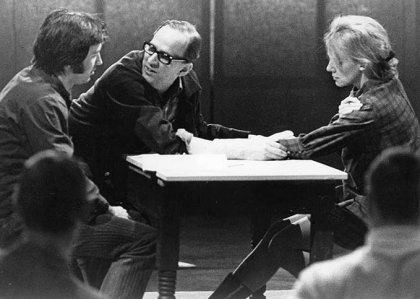
Bergman with Thommy Berggren and Margaretha Byström during rehearsal of Woyzeck.
Photo: Beata Bergström © Musik- och teaterbiblioteket, Statens musikverk
Bergman's strict directing style and refusal to politicise his productions did not go unquestioned at a time when radical and free theatre groups were gaining in influence. Nor did he remain impervious to the criticism. In 1969 he staged one of his most political productions, Woyzeck, inviting the audience to public rehearsals. Three years previously he had also directed Peter Weiss' The Investigation. The playwright to whom Bergman constantly returned, however, was Strindberg, and during this time he staged no fewer than four of the master's plays.
While rehearsing The Dance of Death at The Royal Dramatic Theatre, Bergman was arrested and taken for questioning by the police on suspicion of tax evasion (he was later totally exonerated). Bergman decided to leave Sweden, and following a brief spell in Los Angeles, he moved to Munich, where in 1977 he staged his first production at the Munich Residenztheater. Despite his relative fluency in German, the language was to cause him problems. As a consequence, the majority of the 11 plays he staged in Munich were written by dramatists he was already familiar with, such as Ibsen, Strindberg and Molière. For the first time since Wood Painting in 1955, Bergman staged his own material: the television drama Scenes from a Marriage was adapted for the stage and performed alongside parts of A Doll's House and Miss Julie. During his time in Munich, Bergman received mixed reviews from the critics, some of whom ironically referred to him as St Ingmar. His audiences, however, were somewhat more appreciative.
In 1984 Bergman returned to Sweden and The Royal Dramatic Theatre. With the death of Alf Sjöberg in 1980, he became the director most closely associated with the 'Royal Dramatic Theatre' tradition. Out of respect and admiration for Sjöberg's Shakespeare productions, Bergman had only ventured into one Shakespeare play at The Royal Dramatic Theatre previously, Twelfth Night in 1975, but the time now felt right. King Lear with Jarl Kulle in the title role was the first production on his return.
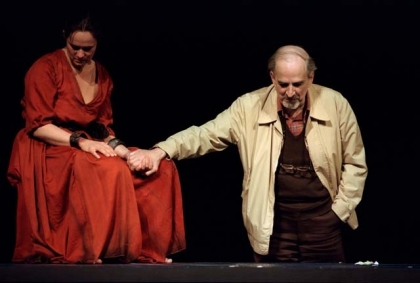
Bergman with Pernilla August during rehearsal of The Winter's Tale.
Photo: Bengt Wanselius © Bengt Wanselius
Perhaps the most famous of all of Bergman's Roayl Dramatic Theatre productions is Hamlet, which according to the director himself was one of his 'most important and angry productions'. Yet the production received only mixed reviews. In The Winter's Tale of 1994, Bergman mixed Shakespeare with the early 19th-century Swedish writer Carl Jonas Love Almqvist. Once again, the perennial Strindberg and Molière featured in the repertoire, while Ibsen had to make do with Bergman's farewell production, his 2002 Ghosts with Pernilla August as Mrs Alving. Virtually all of the director's productions from this period made celebrated guest appearances around the world.

Bergman with Pernilla August and Jonas Malmsjö during rehearsal of Ghosts.
Photo: Bengt Wanselius © Bengt Wanselius
Bergman's difficulties in disengaging himself from the theatre are well documented. Long before Ghosts, many productions were described as his last. In an interview with Marie Nyreröd he spoke of his unwillingness to quit. 'When it comes to the theatre, it's been much worse. I'm far more attached to the theatre than to film. I'd absolutely love to continue with the theatre. But I know that I'm not going to.'
Further reading
Maaret Koskinen, Ingmar Bergman: Allting föreställer, ingenting är, (Nya Doxa, 2001).
Rikard Loman, Avstånd Närhet: Ingmar Bergmans Vintersagan, (Stockholm: Carlsson Bokförlag, 2005).
Lise Lone Marker och Frederick J. Marker, Ingmar Bergman: A Life in the Theater, (Cambridge University Press, 1992).
WT O'Reilly, Ingmar Bergman's theatre direction 1952-1974, (Ann Arbor, Mich.: University Microfilms, 1985).
Henrik Sjögren, Ingmar Bergman på teatern, (Stockholm: Almqvist & Wiksell, 1968).
Henrik Sjögren, Lek och raseri: Ingmar Bergmans teater 1938-2002, (Stockholm: Carlssons Bokförlag, 2002).
Vilgot Sjöman, L 136 – Dagbok med Ingmar Bergman, (Stockholm, P.A. Norstedt & Söners Förlag, 1963).
Birgitta Steene, Ingmar Bergman, A reference guide, (Amsterdam University Press, 2005).
Egil Törnqvist, Bergman och Strindberg: Spöksonaten - drama och iscensättning. Dramaten 1973, Stockholm: Prisma, 1973 (258 p.)
Egil Törnqvist, Between Stage and Screen: Ingmar Bergman Directs, Film Culture in Transition, series ed. Thomas Elsaesser, Amsterdam: Amsterdam University Press, 1995 (243 p.)
Egil Törnqvist, Strindberg's The Ghost Sonata: From Text to Performance, Amsterdam: Amsterdam University Press (269 p.), 2000
Egil Törnqvist, Bergman's Muses: Æsthetic Versatility in Film, Theatre, Television and Radio, Jefferson, NC/London: McFarland, 2003 (265 pp.)
Egil Törnqvist, I Bergmans regi. (297 s.). Amsterdam Contributions to Scandinavian Studies, Vol. 5, red. Henk van der Liet. Amsterdam: Scandinavisch Instituut, Universiteit van Amsterdam, 2008.
Egil Törnqvist, Drama as Text and Performance: Strindberg’s and Bergman’s Miss Julie / Drama som text och föreställning: Strindbergs Fröken Julie och Bergmans. (262 s.). Amsterdam: Amsterdam University Press, 2012.